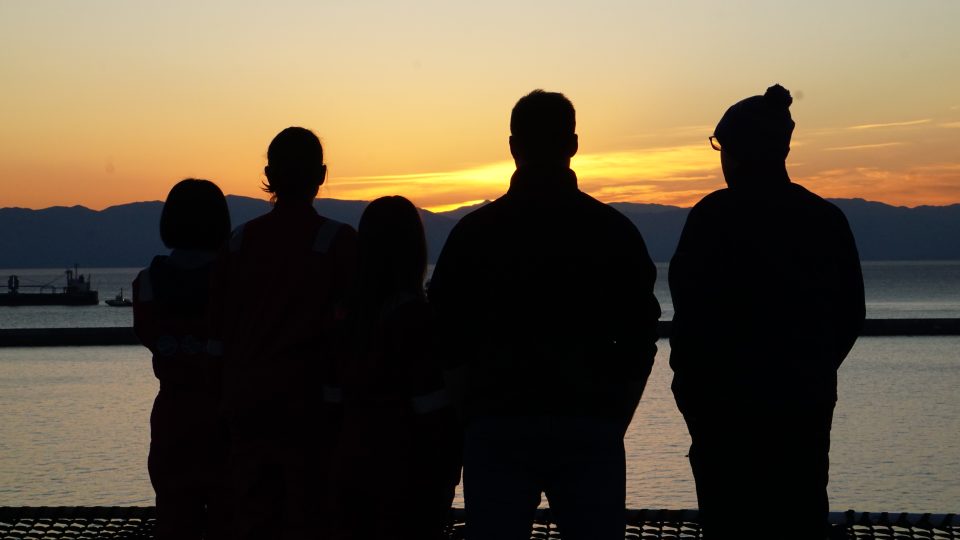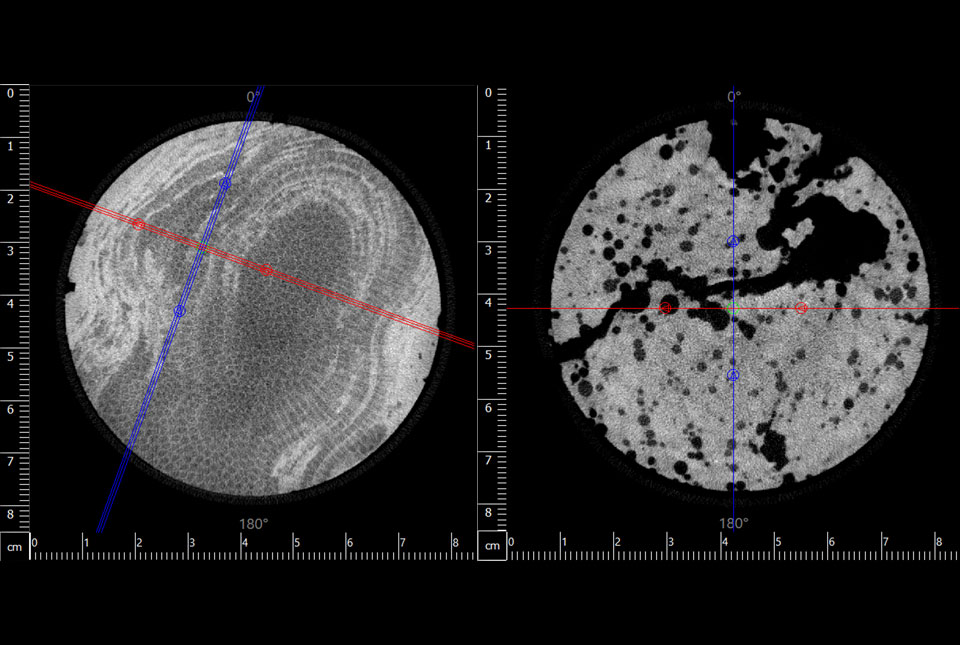IODP Expedition 386: hosting a sampling party in Japan
BGS help lead the final phase of IODP Expedition 386 in Japan, coordinating science colleagues from around the globe to extract samples from sediment cores aboard DV Chikyu.
19/12/2022
In November and December 2022, a team of four BGS scientists helped lead and coordinate the final phase of the International Ocean Discovery Programme’s (IODP) latest expedition, Expedition 386: Japan Trench Paleoseismology. Our role as the European Consortium for Ocean Research Drilling (ECORD) science operator (ESO) was to make sure the wider team was able to work with our colleagues from the Institute for Marine-Earth Exploration and Engineering (MarE3) and the Japan Agency for Marine-Earth Science and Technology (JAMSTEC) in Japan to extract samples from sediment cores collected from the Japan Trench in 2021. The team consisted of 24 scientists from all over the world, including operator staff from the Bremen Core Repository in Germany and the European Petrophysics Consortium at the universities of Leicester and Montpellier.

The members of the sampling party on board DV Chikyu. © P Bellanova.
Disruption caused by COVID-19 meant that this expedition was particularly challenging to manage and complete. We encountered delays caused by travel restrictions, international shipping difficulties, visa applications and troublesome currents, to name just a few. These led to further knock-on complications; looking back now, it’s amazing that we managed to complete this expedition! Following a busy four weeks on board the ship, working 24 hours a day to get the job done, it’s especially satisfying that it finished so successfully.
The reason we were all in Japan was to complete the sampling from 831 m of cores that had already been retrieved from 8 km below the sea surface at the bottom of the Japan Trench. These cores contain valuable records of ancient mega-tsunamis, triggered by the rare but devastating, huge earthquakes that shake this part of the world. The last was the Tōhoku Oki quake in 2011, which measured 9.1 Mw. This triggered a 40 m-high tsunami that swamped the Japanese coast, causing the deaths of over 18 000 people.
The scientists working on our cores use a variety of different techniques to try and determine how, why and when these massive quakes happen, and to understand more about them. Hopefully people who live in earthquake-prone regions around the world can benefit from this knowledge and help prepare for further events in future.

DV Chikyu, the team’s home for four weeks. © M Mowat / BGS.
Over the course of the expedition we were based on a ship, the Drilling Vessel Chikyu , which stayed docked in the port of Shimizu for the duration of the personal sampling party (PSP). Our job was to take all the samples for the many different research projects. In total, 18 192 individual samples were taken from the cores in the dedicated laboratories on board the ship. We worked 24 hours a day in 12-hour shifts, carefully inserting the sample tools into the soft, muddy sediments, removing the intact samples and bagging and labelling them for shipment to labs around the world.
Every day the scientists and ESO staff, working with MarE3 and Marine Works Japan staff, took their places at the four sampling tables in the lab, with space for two or three people at each table. There was a lot of laughter and smiles from the teams, most of whom had never met before. The atmosphere was always fun and positive, despite the careful and methodical nature of what we had to do.

Taking just one of the 18 192 individual samples. © P Bellanova.
Due to COVID-19 restrictions, we had to remain on the ship for the duration of the PSP, only being able to take a short stroll or run on the dockside for exercise. Unfortunately no trips ‘ashore’ for us! Off-shift opportunities were fairly limited, but everyone made the most of their time. Sunrises and sunsets were spectacular from the heli-deck and a welcome excuse to get outside, talk to colleagues and soak up the beautiful scenery as the day changed over this part of eastern Japan.

Sunset from the DV Chikyu. © J Everest / BGS.
During meals, COVID-19 restrictions meant we were not able to linger to discuss the delicious menu put in front of us every day, but that didn’t stop early diners getting the word out to friends that ‘Tantanmen is amaaaazing today!’ or ‘You have to get the spicy udon before it all goes!’ The food was spectacularly good and provided a talking point during every shift.

Some of the fabulous food that was served up on board! © M Stewart / BGS.
Despite the busy schedule, the BGS team helped our fellow scientists talk to the rest of the world as well. Our Taiwanese colleagues gave a guided virtual video tour through the labs to schools and university students back home; various researchers continued their normal lectures, now old hands with Zoom due to months of lockdown, and the BGS team and co-chief scientists spoke to loads of schools across Scotland, taking pupils behind the scenes of the expedition and providing a taste of life on board.


Life on board the Chikyu – watch Hannah’s video diary.
The final sample was extracted on 24 November 2022 and, after a few days of tidying, packing and generally organising everything, the scientists and most of the operator staff left the ship. Margaret Stewart and I stayed on board to help complete the reviews of the huge report that has to accompany every sampling party and conclude every IODP expedition. It has been a massive undertaking, involving dozens of operator staff in the UK, Germany and of course Japan, plus scientists from every part of the globe.
We coordinated the expedition during one of the most challenging periods in modern times. It wasn’t easy, but we made it, and we know that the resulting research will enhance our understanding of earthquake and tsunami science and bring huge benefits to millions of people who live in these unstable regions of the planet.
About the author

Dr Jeremy Everest
Glacial geologist
Relative topics
Related news

BGS scientists join international expedition off the coast of New England
20/05/2025
Latest IODP research project investigates freshened water under the ocean floor.

New seabed geology maps to enable long term conservation around Ascension Island
01/04/2025
BGS deliver the first marine geology and habitat maps for one of the world’s largest marine protected areas.

New study reveals long-term effects of deep-sea mining and first signs of biological recovery
27/03/2025
BGS geologists were involved in new study revealing the long-term effects of seabed mining tracks, 44 years after deep-sea trials in the Pacific Ocean.

Seabed geology data: results from stakeholder consultation
31/01/2025
BGS collected valuable stakeholder feedback as part of a new Crown Estate-led initiative to improve understanding of national-scale seabed geology requirements.

UKGravelBarriers
Increasing our understanding and modeling capabilities of gravel beach and barrier dynamics.

Monitoring coastal change from space
BGS is helping to develop applications that detect and track coastal erosion and accretion from space to inform coastal management plans.

New research reveals the secrets of the seabed off the East Anglian coast
11/07/2024
New geological map will help in the hunt for new renewable energy opportunities whilst protecting delicate marine ecosystems.

BGS awarded research grant to support potential offshore wind development in Iceland
13/05/2024
BGS has been awarded the NERC-Arctic grant for a collaboration project with Iceland GeoSurvey.

Largest CT core scan completed at the BGS Core Scanning Facility
09/05/2024
BGS has completed its largest CT core scan project to date, with around 400 m of core imaged for the IODP Drowned Reefs project.

Scientists produce first record of environmental data off coast of Hawai’i
01/03/2024
An international team of researchers, including BGS geoscientists, have succeeded in acquiring a continuous record of environmental data using fossilised coral from Hawai’i.





